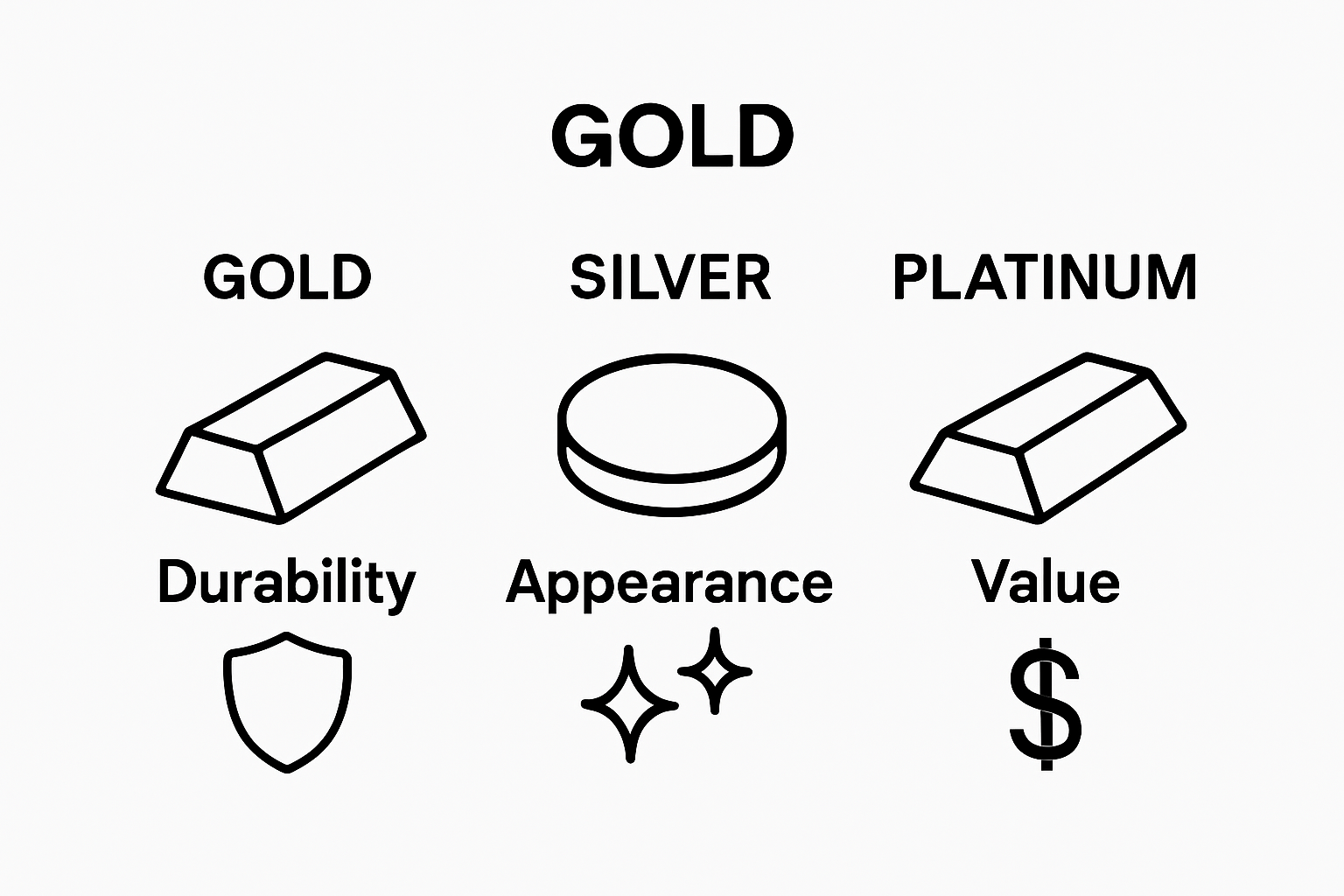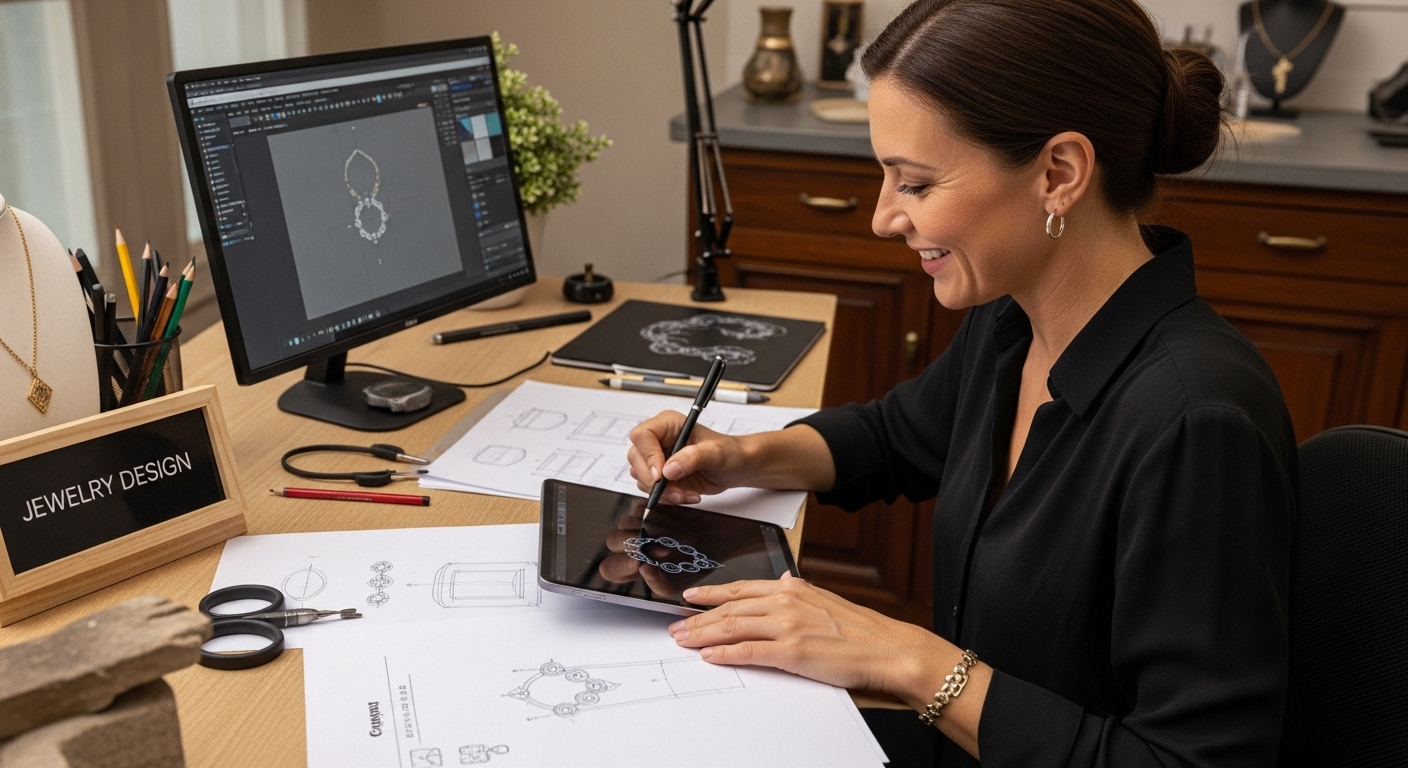Jewelry making sits at the crossroads of tradition and innovation, shaping stories out of metal and stone. Most people think it is just about pretty gems, but the real magic is in the skills behind the scenes. Professional training covers techniques like sawing, filing, and even soldering with microscopic precision and this backstage artistry is what elevates a simple ring or necklace into something people cherish for generations.
Table of Contents
- The Foundations Of Jewelry Making: What It Entails
- The Importance Of Materials In Jewelry Creation
- Techniques In Jewelry Making: Crafting Beauty
- The Role Of Design In Jewelry And Its Significance
- From Concept To Creation: Understanding The Journey Of Jewelry
Quick Summary
| Takeaway | Explanation |
|---|---|
| Understand core materials: metals and gemstones | Knowing the characteristics of metals and gemstones is crucial for creating meaningful jewelry designs. |
| Master essential jewelry techniques | Techniques like soldering, sawing, and forming are foundational skills for transforming materials into artistic pieces. |
| Incorporate design principles strategically | Effective jewelry design balances aesthetics, functionality, and personal symbolism for enhanced emotional significance. |
| Embrace technology in design | Utilize digital tools like CAD and 3D printing to refine and prototype designs before production, improving precision and creativity. |
| Iterate during the creation process | Continuously refine your designs by evaluating structural integrity, wearability, and aesthetic appeal for optimal results. |
The Foundations of Jewelry Making: What It Entails
Jewelry making is a sophisticated craft that blends artistic creativity with technical precision, transforming raw materials into wearable art. This intricate process involves understanding fundamental techniques, materials, and design principles that have evolved over thousands of years.
The Essential Materials of Jewelry Crafting
At the core of jewelry making are the primary materials that artisans work with. Metals form the fundamental backbone of most jewelry pieces, ranging from precious options like gold, silver, and platinum to more affordable alternatives such as copper and brass. Each metal brings unique characteristics:
- Gold: Valued for its lustrous appearance and resistance to tarnishing
- Silver: Versatile and more affordable, popular in contemporary designs
- Platinum: Extremely durable and hypoallergenic, ideal for fine jewelry
Beyond metals, jewelry makers incorporate gemstones, which add color, brilliance, and personal significance to their creations.
To help clarify the different metals and gemstones used in jewelry making, the table below summarizes the core materials featured in the article, along with their main characteristics and significance.
| Material | Type | Key Characteristics | Typical Role in Jewelry |
|---|---|---|---|
| Gold | Precious Metal | Lustrous, resistant to tarnishing, highly malleable | Premium settings, heirloom pieces |
| Silver | Precious Metal | Versatile, affordable, excellent conductivity | Contemporary and classic designs |
| Platinum | Precious Metal | Extremely durable, hypoallergenic, resists wear and corrosion | Fine jewelry, engagement rings |
| Copper | Base Metal | Affordable, reddish hue, develops patina over time | Alternative jewelry, alloys |
| Brass | Base Metal | Yellow hue, strong, cost-effective | Costume jewelry, fashion pieces |
| Diamonds | Gemstone | Exceptional brilliance, extreme hardness | Symbolic/resonance, centerpieces |
| Rubies, Sapphires | Gemstone | Vibrant colors, symbolic meanings, durable | Highlights, accents, focal points |
| Amethyst, Topaz, Turquoise | Gemstone | Wide range of colors, varying hardness and optical properties | Personalization, color accents |
Techniques and Skill Development
Jewelry making requires mastering a range of sophisticated techniques. According to Rhode Island School of Design, professional training involves learning intricate skills like sawing, filing, forming, soldering, and polishing. These methods transform raw materials into intricate designs that tell stories and capture personal expressions.
Traditional metalworking techniques remain crucial in contemporary jewelry design.
Artisans use specialized tools like jeweler’s saws, files, hammers, and soldering equipment to shape, cut, and join metal components with remarkable precision. Read more about special occasion jewelry design to understand how these techniques translate into meaningful pieces.
The craft of jewelry making is not just about technical skill but also about understanding design principles, material properties, and the emotional resonance of each piece. Whether creating a delicate wedding ring or a bold statement necklace, jewelry makers blend technical expertise with artistic vision to produce objects of beauty and personal significance.
The Importance of Materials in Jewelry Creation
Materials are the fundamental building blocks of jewelry design, determining not just the aesthetic appeal but also the intrinsic value, durability, and emotional significance of each piece. Understanding the nuanced properties of different materials helps jewelry makers create pieces that transcend mere decoration and become meaningful personal artifacts.
Metallurgical Considerations in Jewelry Design
The selection of metals represents a critical decision in jewelry creation. Precious metals like gold, silver, and platinum offer unique characteristics that influence a piece’s quality and performance. According to Encyclopaedia Britannica, each metal brings distinct properties that impact design possibilities:

- Gold: Offers exceptional malleability and resistance to corrosion
- Silver: Provides affordability and excellent conductivity
- Platinum: Delivers supreme durability and hypoallergenic properties
Beyond pure metals, artisans frequently work with alloys, which combine multiple metals to enhance specific characteristics. These hybrid materials can improve strength, adjust color, and modify pricing, allowing designers to optimize their creations for different aesthetic and functional requirements.
Gemstones: More Than Decorative Elements
Gemstones are not merely ornamental additions but complex materials with profound scientific and cultural significance. Each stone carries unique geological history, optical properties, and symbolic meaning. Jewelers carefully consider factors like hardness, transparency, color intensity, and potential treatment processes when selecting gemstones.
The interplay between metals and gemstones creates a complex design language. A well-chosen stone can transform a simple metal setting into a narrative of personal expression. Learn more about creating meaningful anniversary gifts to understand how material selection communicates deeper emotional connections.
Ultimately, material selection in jewelry making is a sophisticated art form that balances scientific understanding with creative vision. The right combination of metals and stones can elevate a piece from a mere accessory to a treasured personal artifact that tells a unique story.
Techniques in Jewelry Making: Crafting Beauty
Jewelry making is a sophisticated craft that transforms raw materials into intricate wearable art through a complex array of specialized techniques. These methods require precision, creativity, and an intimate understanding of material properties, allowing artisans to translate design concepts into tangible, beautiful pieces.
Fundamental Metalworking Techniques
At the heart of jewelry creation are core metalworking techniques that form the foundation of design execution. According to Kent State University’s Jewelry Program, professional jewelers master several critical skills:
- Cold connection methods for joining metals without heat
- Silver soldering for creating permanent metal bonds
- Small-scale fabrication techniques
- Metal forming and cold forging processes
Precision tools play a crucial role in these techniques. Jewelers utilize specialized equipment like jeweler’s saws, files, hammers, and precision measuring instruments to shape, cut, and refine metal components with microscopic accuracy. Each tool serves a specific purpose, enabling artisans to manipulate materials with extraordinary detail.
Advanced Design and Fabrication Skills
Beyond basic metalworking, jewelry making involves sophisticated design principles. Contemporary jewelers blend traditional craftsmanship with innovative approaches, using techniques that transform conceptual designs into wearable art. Explore our guide to meaningful anniversary gifts to understand how technical skill translates into emotional significance.
Bezel setting, stone mounting, and intricate metalwork represent advanced skills that distinguish exceptional jewelry design. These techniques require not just technical proficiency but also an artistic sensibility that understands how form, texture, and composition interact to create visually compelling pieces.
Ultimately, jewelry making is a delicate balance between scientific precision and creative expression. Each technique represents a nuanced dialogue between the artisan’s vision and the material’s inherent properties, resulting in objects that are both functional adornments and miniature sculptures of personal meaning.
The Role of Design in Jewelry and Its Significance
Design represents the critical intersection between artistic vision and functional creation in jewelry making, transforming raw materials into meaningful personal expressions. More than mere aesthetic arrangement, design embodies a complex language of visual communication that connects emotional narratives with tangible craftsmanship.
Design Principles in Jewelry Creation
Effective jewelry design demands a sophisticated understanding of multiple interconnected elements. Visual composition plays a pivotal role, requiring designers to balance proportion, symmetry, color harmony, and spatial relationships. According to research exploring design economics in creative industries, design transcends pure aesthetics and carries significant economic and cultural value:
- Creating visual narratives through strategic element placement
- Balancing functional requirements with aesthetic appeal
- Communicating personal and cultural symbolism through design choices
Color perception emerges as a critical design component, influencing how viewers emotionally engage with jewelry pieces. Designers strategically utilize color theory to evoke specific psychological responses, transforming jewelry from mere accessories into powerful communication tools.
Emotional and Cultural Significance of Design
Jewelry design represents a nuanced dialogue between creator and wearer, embedding personal stories and cultural meanings within each piece. Every design choice communicates something profound about identity, heritage, and individual expression. Learn more about creating meaningful anniversary gifts to understand how design translates emotional connections into tangible forms.
Beyond visual appeal, exceptional jewelry design considers ergonomics, wearability, and individual comfort. A truly remarkable piece seamlessly integrates aesthetic beauty with practical functionality, ensuring that the wearer experiences both visual delight and physical comfort.
Ultimately, design in jewelry making is an intricate art form that bridges technical skill, creative imagination, and deep human emotional understanding. Each piece becomes a miniature sculpture that tells a unique story, connecting personal narratives through the universal language of beauty and craftsmanship.
From Concept to Creation: Understanding the Journey of Jewelry
The transformation of a jewelry design from an initial concept to a finished piece represents a complex, multifaceted journey that combines artistic vision, technical expertise, and meticulous craftsmanship. This intricate process involves numerous stages that demand precision, creativity, and an intimate understanding of materials and design principles.

The Design and Conceptualization Phase
Initial design development begins with inspiration and conceptual sketching, where jewelers translate abstract ideas into tangible visual representations. According to the Gemological Institute of America, contemporary jewelry design incorporates both traditional drawing techniques and advanced digital technologies:
- Hand-drawn conceptual sketches exploring initial design ideas
- Digital rendering using Computer-Aided Design (CAD) software
- Developing detailed technical drawings with precise measurements
Technological innovations have dramatically transformed the design process. Modern jewelers leverage sophisticated software and 3D printing technologies to create incredibly precise prototypes, allowing designers to experiment and refine concepts with unprecedented accuracy before actual production begins.
Prototype and Production Refinement
Once a design is conceptualized, jewelers move into the critical prototype phase. This stage involves creating physical or digital models that test the feasibility of the original concept. Explore our guide to understanding meaningful gifts to appreciate how design considerations translate into emotional resonance.
Prototyping allows designers to evaluate multiple critical aspects:
- Structural integrity of the design
- Wearability and ergonomic considerations
- Material compatibility and potential manufacturing challenges
The journey from concept to creation is not linear but an iterative process of continuous refinement.
The table below outlines the key stages in the jewelry-making process, highlighting the primary tasks and technologies involved at each step for better understanding of the journey from concept to finished creation.
| Stage | Main Activities | Tools & Techniques | Purpose/Outcome |
|---|---|---|---|
| Design & Conceptualization | Inspiration, sketching, CAD rendering, technical drawings | Sketchbooks, CAD software | Translate abstract ideas into visual plans |
| Prototype Development | Creating physical or digital models, testing feasibility | 3D printing, modeling tools | Evaluate structure, wearability, compatibility |
| Production & Refinement | Material selection, fabrication, assembly, quality checks | Saws, files, soldering, polishing | Build and perfect the wearable piece |
| Final Finishing | Polishing, setting stones, final adjustments | Polishing wheels, stone setting tools | Achieve the desired appearance and quality |
| Quality Assurance | Reviewing integrity, usability, and aesthetics | Inspection tools, expert review | Ensure piece meets artistic and functional standards |
Ultimately, successful jewelry design represents a harmonious dialogue between creative imagination and technical execution. It transforms abstract artistic vision into wearable art that communicates personal stories, cultural meanings, and individual expressions through the universal language of craftsmanship.
Bring the Art of Jewelry Making to Your Next Gift
You’ve just learned how the journey from raw materials to meaningful jewelry requires both technical mastery and emotional intention. Yet many shoppers struggle to find gifts that capture this unique blend of craftsmanship and personal sentiment. Are you searching for a piece that combines quality materials, expert techniques, and a one-of-a-kind touch?

Let Treasured Tale Store turn inspiration into reality. Our personalized jewelry collection and engraved gifts allow you to choose metals and messages that speak directly to your heart. Instead of generic presents, show your loved ones how much you care with a design that is tailored just for them. Explore now and celebrate any special occasion with a gift that feels truly handcrafted. Start your journey towards a memorable gift today at Treasured Tale Store.
Frequently Asked Questions
What are the main materials used in jewelry making?
Jewelry makers primarily use metals, such as gold, silver, and platinum, as well as affordable alternatives like copper and brass. Gemstones are also key components, adding color and significance to pieces.
What techniques are essential for crafting jewelry?
Essential techniques include sawing, filing, forming, soldering, and polishing. Mastery of these techniques allows artisans to transform raw materials into intricate designs.
How do jewelry artisans choose gemstones?
Jewelry artisans consider factors such as hardness, transparency, color intensity, and symbolic meanings when selecting gemstones for their designs, ensuring they complement the overall aesthetic and emotional intention of the piece.
What role does design play in jewelry making?
Design is crucial in jewelry making as it combines artistic vision with functionality. Effective jewelry design balances form, color, and symbolism to create meaningful pieces that resonate with the wearer.




